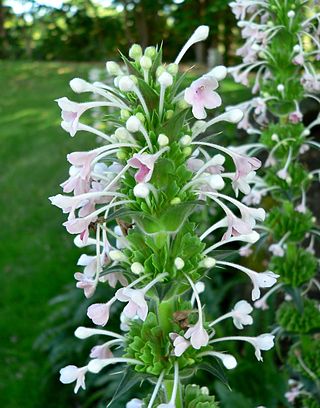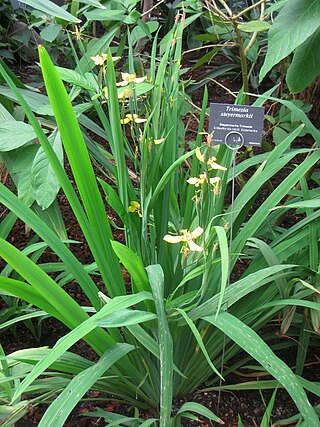
The Dipsacales are an order of flowering plants, included within the asterid group of dicotyledons. In the APG III system of 2009, the order includes only two families, Adoxaceae and a broadly defined Caprifoliaceae. Some well-known members of the Dipsacales order are honeysuckle, elder, viburnum, and valerian.

The Caprifoliaceae or honeysuckle family is a clade of dicotyledonous flowering plants consisting of about 860 species, in 33, to 42 genera, with a nearly cosmopolitan distribution. Centres of diversity are found in eastern North America and eastern Asia, while they are absent in tropical and southern Africa.

In the botanical classification of plants, Aeridinae Pfitzer is a subtribe of the tribe Vandeae whose representatives all have a monopodial growth habit and do not possess pseudobulbs.

Myrtaceae, the myrtle family, is a family of dicotyledonous plants placed within the order Myrtales. Myrtle, pōhutukawa, bay rum tree, clove, guava, acca (feijoa), allspice, and eucalyptus are some notable members of this group. All species are woody, contain essential oils, and have flower parts in multiples of four or five. The leaves are evergreen, alternate to mostly opposite, simple, and usually entire. The flowers have a base number of five petals, though in several genera, the petals are minute or absent. The stamens are usually very conspicuous, brightly coloured, and numerous.

Abelia is a previously recognized genus that contained about 30 species and hybrids, placed in the honeysuckle family, Caprifoliaceae. Molecular phylogenetic studies showed that the genus was not monophyletic, and in 2013, Maarten Christenhusz proposed the merger of Abelia into Linnaea, along with some other genera. Abelia section Zabelia was raised to the genus Zabelia.

Dipsacus is a genus of flowering plant in the family Caprifoliaceae. The members of this genus are known as teasel, teazel or teazle. The genus includes about 15 species of tall herbaceous biennial plants growing to 1–2.5 metres (3.3–8.2 ft) tall. Dipsacus species are native to Europe, Asia and northern Africa.

Succisella is a genus of flowering plants in the family Caprifoliaceae. There are four or five species in the genus. They are all native to Europe; three are endemic to the Iberian Peninsula.

Morinoideae is a subfamily of plants in the family Caprifoliaceae, order Dipsacales. It was at one time recognized as the separate family Morinaceae. The genus Morina has also been included in a separate family Dipsacaceae, currently included in Caprifoliaceae. Three genera have been included in this subfamily:

Linaceae is a family of flowering plants. The family is cosmopolitan, and includes about 250 species in 14 genera, classified into two subfamilies: the Linoideae and Hugonioideae. Leaves of the Linaceae are always simple; arrangement varies from alternate to opposite or whorled. The hermaphroditic, actinomorphic flowers are pentameric or, very rarely, tetrameric.

Rebutia is a genus of flowering plants in the family Cactaceae, native to Bolivia and Argentina. They are generally small, colorful cacti, globular in form, which freely produce flowers that are relatively large in relation to the body. They have no distinctive ribs, but do have regularly arranged small tubercles. They are considered fairly easy to grow and they may produce large quantities of seeds that germinate freely around the parent plant.

Lomelosia caucasica, the Caucasian pincushion flower, pincushion-flower or Caucasian scabious, is a species of flowering plant in the family Caprifoliaceae, native to the Caucasus, north eastern Turkey, and northern Iran. Growing to 60 cm (24 in) tall and broad, it is a clump-forming perennial with grey-green, divided leaves. Pincushion-shaped buds, borne on erect hairy, stems, open to pale blue or lavender flower heads, 4–8 cm (2–3 in) in diameter, from late summer through to autumn.

Dipsacus pilosus, or small teasel, is a species of biennial flowering plant in the family Caprifoliaceae. The epithet small refers to the flower heads which are smaller, globular and made up of white flowers with violet anthers and woolly spines.

Linnaea is a plant genus in the honeysuckle family Caprifoliaceae. Until 2013, the genus included a single species, Linnaea borealis. In 2013, on the basis of molecular phylogenetic evidence, the genus was expanded to include species formerly placed in Abelia, Diabelia, Dipelta, Kolkwitzia and Vesalea. However, this is rejected by the majority of subsequent scientific literature and flora.

Linnaea amabilis, also known under the synonym Kolkwitzia amabilis and the English name beauty bush, is a species of flowering plant in the family Caprifoliaceae. It is a deciduous shrub grown as an ornamental plant. In China, where it originated, the plant is called wèi shí (蝟实).

Trimezia is a genus of flowering plants in the family Iridaceae, native to the warmer parts of southern Mexico, Central America, South America, Florida, and the West Indies. Trimezia is placed in the tribe Trimezieae. The division of the tribe into genera has varied considerably. In one approach, it contains only the genus Trimezia, which then includes the genera Neomarica, Pseudotrimezia and Pseudiris. In other approaches, two to five genera are recognized, sometimes also including the genus Deluciris.

Dipsacus laciniatus is a species of flowering plant in the honeysuckle family known by the common name cutleaf teasel. It is native to Europe and Asia. It is present in North America as an introduced species and invasive weed.

Linnaea parvifolia, synonym Abelia schumannii, is a species of flowering plant in the family Caprifoliaceae, native to central China. It is a semi-evergreen shrub growing to 2 m (7 ft) tall by 3 m (10 ft) broad. Pink flowers with red calyces are produced in late summer and autumn.

Pycnocomon is a genus of flowering plants belonging to the family Caprifoliaceae. They were formerly placed in the defunct family of Dipsacaceae.


















